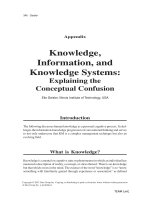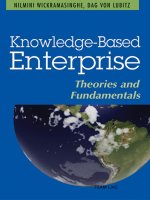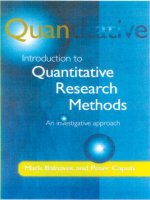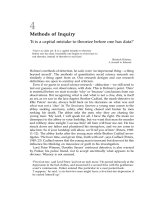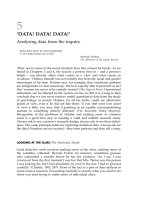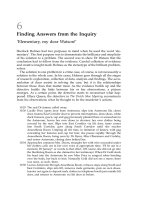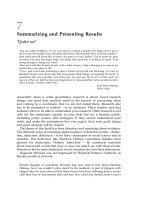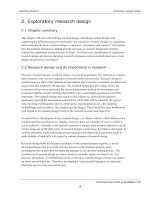Personality classic theories and modern research 6th chapter 2 how iss personality studied and assessed
Bạn đang xem bản rút gọn của tài liệu. Xem và tải ngay bản đầy đủ của tài liệu tại đây (277.45 KB, 31 trang )
Personality
Sixth edition
Chapter 2
How Is Personality
Studied and Assessed?
Copyright © 2016, 2012, 2009 Pearson Education, Inc. All Rights Reserved
Modules
Introduction: How Is Personality Studied and Assessed?
2.1: Measuring Personality
2.2: Bias
2.3: Varieties of Personality Measures
2.4: How Not to Test Personality
2.5: The Design of Research
2.6: The Ethics of Personality Testing
Conclusion: How Is Personality Studied and Assessed?
Copyright © 2016, 2012, 2009 Pearson Education, Inc. All Rights Reserved
Learning Objectives (1 of 2)
2.1: Report some of the parameters of measuring personality
2.2: Analyze the three major sources of bias in personality measurement
2.3: Express the different types of measures of personality
2.4: Review reasons why some personality tests should not be used
Copyright © 2016, 2012, 2009 Pearson Education, Inc. All Rights Reserved
Learning Objectives (2 of 2)
2.5: Describe the three basic types of research designs used in studying personality
2.6: Examine the ethical context of psychological testing
Copyright © 2016, 2012, 2009 Pearson Education, Inc. All Rights Reserved
Introduction: How Is Personality Studied and Assessed?
− Objective assessment
− Subjective assessment
Copyright © 2016, 2012, 2009 Pearson Education, Inc. All Rights Reserved
2.1: Measuring Personality
Objective: Report some of the parameters of measuring personality
Characteristics of charismatic people
Affective Communication Test (ACT)
Copyright © 2016, 2012, 2009 Pearson Education, Inc. All Rights Reserved
2.1.1: Reliability
− Internal Consistency Reliability
− Test-Retest Reliability
− Challenges of personality change
Copyright © 2016, 2012, 2009 Pearson Education, Inc. All Rights Reserved
2.1.2: Construct Validity
− Construct validity
− Theory development
− Content validity
Copyright © 2016, 2012, 2009 Pearson Education, Inc. All Rights Reserved
2.2: Bias
Objective: Analyze the three major sources of bias in personality measurement
Ethnic bias
Gender bias
Copyright © 2016, 2012, 2009 Pearson Education, Inc. All Rights Reserved
2.2.1: Response Sets
− Methods to counter response sets
− Social desirability response set
− Methods to prevent social desirability response sets
Copyright © 2016, 2012, 2009 Pearson Education, Inc. All Rights Reserved
2.3: Varieties of Personality Measures
Objective: Express the different types of measures of personality
Theoretical reasons
Methodological reasons
Copyright © 2016, 2012, 2009 Pearson Education, Inc. All Rights Reserved
2.3.1: Self-Report Tests
− Minnesota Multiphasic Personality Inventory (MMPI)
− NEO Personality Inventory (NEO-PI)
− Personality Research Form (PRF)
Copyright © 2016, 2012, 2009 Pearson Education, Inc. All Rights Reserved
2.3.2: Q-Sort Tests
− Overview
− Advantages
Copyright © 2016, 2012, 2009 Pearson Education, Inc. All Rights Reserved
2.3.3: Ratings and Judgments by Others
− Stanford-Binet intelligence test
− Dimensions
− Advantages
Copyright © 2016, 2012, 2009 Pearson Education, Inc. All Rights Reserved
Figure 2.1: A Sample of Questions from Terman’s Longitudinal Study
Through questionnaires such as these, Terman obtained information from the parents and teachers of the children he was studying. These childhood ratings
have been shown to be predictive of adult personality and accomplishment.
Copyright © 2016, 2012, 2009 Pearson Education, Inc. All Rights Reserved
2.3.4: Biological Measures
− Phrenology
− Electroencephalograms (EEGs)
− Position Emission Tomography (PET)
− Functional Magnetic Resonance Imaging (fMRI)
− Biological assessments of diseases and genetic conditions
Copyright © 2016, 2012, 2009 Pearson Education, Inc. All Rights Reserved
2.3.5: Behavioral Observations
− Sir Francis Galton’s approaches
− Overview
Copyright © 2016, 2012, 2009 Pearson Education, Inc. All Rights Reserved
2.3.6: Interviews
− Psychotherapeutic interviews
− Structured interviews
Copyright © 2016, 2012, 2009 Pearson Education, Inc. All Rights Reserved
2.3.7: Expressive Behavior
− Overview
− Expressive style of charismatic people
Copyright © 2016, 2012, 2009 Pearson Education, Inc. All Rights Reserved
2.3.8: Document Analysis and Biological Studies
− Document analysis
− Examples of biographical studies
Copyright © 2016, 2012, 2009 Pearson Education, Inc. All Rights Reserved
2.3.9: Projective Tests
− Overview
− The Rorschach test
− Thematic Apperception Test (TAT)
Copyright © 2016, 2012, 2009 Pearson Education, Inc. All Rights Reserved
2.3.10: Demographics and Lifestyle
− Astrology
− Demographic information
− Examples of societal influences
Copyright © 2016, 2012, 2009 Pearson Education, Inc. All Rights Reserved
2.3.11: Online Internet Analysis of Social Media and Big Data
− Reasons for organizations assessing personalities
− Problems of implementing big data methods
Copyright © 2016, 2012, 2009 Pearson Education, Inc. All Rights Reserved
2.3.12: Is There One Best Method of Assessment?
− Relevant factors
− Best approach
Copyright © 2016, 2012, 2009 Pearson Education, Inc. All Rights Reserved
2.4: How Not to Test Personality
Objective: Review reasons why some personality tests should not be used
Dubious personality assessments
Graphology
Copyright © 2016, 2012, 2009 Pearson Education, Inc. All Rights Reserved
